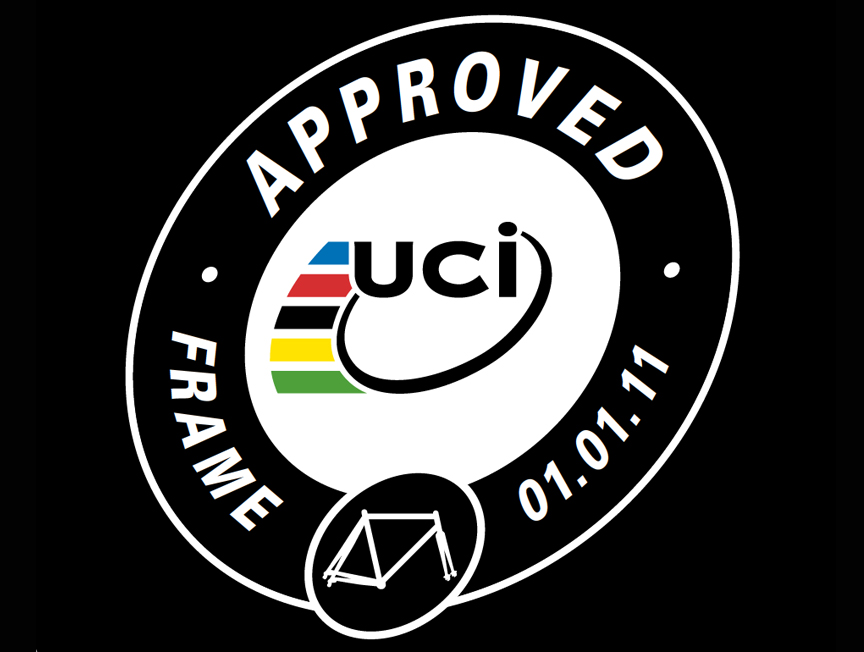UCI 'approved' stickers to adorn racing bikes


The International Cycling Union (UCI) has published on its website further details of the protocol that will eventually see all bikes used in the professional ranks adorned with 'UCI approved' stickers.
The system, first proposed last year, is designed to ensure all bikes used in professional races adhere to the governing body's technical regulations. The stickers will have to be displayed on bikes used in road, track and cycle cross races.
The stickers will be provided for frames (and forks) only when they have gone through the UCI's new Approval Protocol that came in to action from January 1 this year. It will not be applied to frames that are already on sale or in production.
Frames made in moulds will have to go through the full Approval Protocol with initial drawings submitted for approval by the UCI before a prototype is again submitted. More traditional 'tubular' frames made by welding or glueing tubes together will go through a shorter protocol whereby they are approved by the UCI via the technical drawings alone.
The full Approval Protocol could add several months to a manufacturers production schedule, and threatens to limit the amount of new products seen at bike races through the season.
A manufacturer will have to get each of its models approved (the approval is limited to eight frame sizes) before they can be raced on, and a frame that undergoes design changes will have to go through the procedure each time.
The rules don't stop there either:
The latest race content, interviews, features, reviews and expert buying guides, direct to your inbox!
The positioning of the sticker on the frame also has to be approved by the UCI. It will have its own identification code (paired with the certificate the manufacturer receives) and must be visible, indelible and inseparable from the frame.
Not only that but the manufacturers will have to pay for the privilege. The UCI claim the costs involved merely cover the expense of the procedure. The full Approval Protocol will cost £7,800 + VAT while the simplified procedure (for tubular frames) will cost just £500 + VAT.
A list of approved models will be available on the UCI's website and they will be entitled to carry out random checks at the start of bikes races.
The approval system is set to be eventually rolled out to all parts of a bike, and restrictions on clothing have already been announced. A team must register a specimen of clothing with the UCI at the start of the year, and 'riders clothing shall always be identical to the specimen lodged.' Team Sky had several different jerseys last year, each one designed for different weather conditions.
The UCI claim, with no hint of irony, that 'the approval for frames and forks is a service that the UCI has set up for manufacturers... and the sport in general.'
Several questions remain: The Approval Protocol states; 'From this date, all new frames and forks used by licence holders in road, track and cyclo-cross events must be approved on the basis of this Protocol.'
Does this mean 'all' licence holders? British Cycling events are run under the rules and regulations of the UCI, and seeing as the technical regulations cover your average third category race, it seem we all have to race on stickered up bikes as of 2012.
What if someon fancies getting a custom made Brian Rourke frame for a season? Will the sticker have to be displayed on that? Who would pay the UCI for the privilege?
Secondly, do all applications for a given year have to be approved before January 1 of that year, or is it a rolling system where an application can be submitted at any time and is then approved as soon as the UCI give it the all clear?
As is often the way, a new set of UCI rules leave more questions than they answer.
Related links
UCI introduces approved equipment scheme

Editor of Cycling Weekly magazine, Simon has been working at the title since 2001. He first fell in love with cycling in 1989 when watching the Tour de France on Channel 4, started racing in 1995 and in 2000 he spent one season racing in Belgium. During his time at CW (and Cycle Sport magazine) he has written product reviews, fitness features, pro interviews, race coverage and news. He has covered the Tour de France more times than he can remember along with the 2008 and 2012 Olympic Games and many other international and UK domestic races. He became the 134-year-old magazine's 13th editor in 2015 and can still be seen riding bikes around the lanes of Surrey, Sussex and Kent. Albeit a bit slower than before.